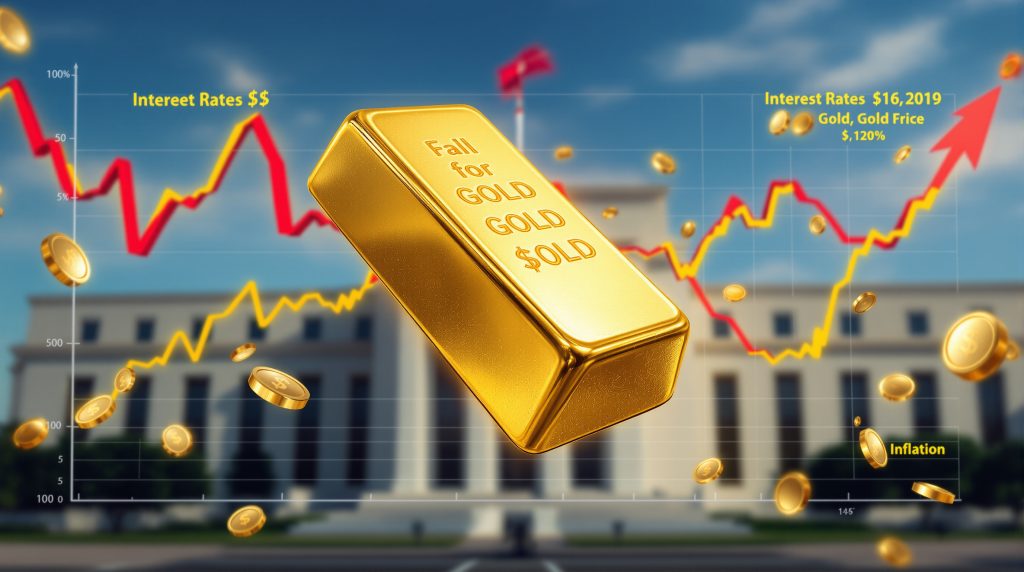Understanding the Gold-Interest Rate Relationship
The relationship between interest rates and gold prices is multifaceted, involving several economic mechanisms that work simultaneously. In this context, the impact of interest rate changes on gold prices is a central concern for investors. Furthermore, research from the World Gold Council reveals that gold competes with interest-bearing investments and creates complex dynamics in global portfolios. For instance, an all-time high analysis confirms evolving trends.
The conventional wisdom suggests a simple inverse correlation. However, statistical analysis shows that the relationship is far more nuanced. According to research, gold’s price movement is only about 16% correlated with real interest rate changes. Therefore, 84% of the movement is driven by other factors, emphasising the importance of a holistic approach.
What Drives the Connection Between Gold and Interest Rates?
Gold's status as a non-yield-bearing asset creates a fundamental divide from interest-bearing investments. Historical data from the Federal Reserve illustrates that this relationship evolves over time. In addition, the World Gold Council notes that gold and interest rates often react to similar underlying economic conditions. For example, both may respond similarly during periods of economic upheaval.
A recent study highlighted that during periods of economic stress, investors tend to reallocate funds from bonds to gold. This shift is partly explained by the psychological comfort of holding precious metals. In addition, investors often search for a historic price surge during volatile times.
The Opportunity Cost Mechanism
Interest rate changes directly affect the opportunity cost of holding gold. Unlike bonds or bank deposits, physical gold generates no passive income. Consequently, investors must constantly evaluate the financial trade-offs. When central banks raise rates, yields on cash deposits increase, reducing gold’s relative appeal. Conversely, when rates fall, gold becomes a more attractive store of value.
Furthermore, as rates decrease, gold offers an alternative opportunity with record highs as inflation hedge. This phenomenon is a key driver behind shifts in investor behaviour, as demonstrated in various risk management studies conducted in recent years.
How Different Types of Interest Rates Impact Gold
Not all interest rates affect gold in the same way. The distinction between nominal and real rates, as well as the duration of rate changes, creates a complex web of influences on gold price movements. In addition, the nuances in these rates reflect different market sentiments and economic indicators.
Nominal vs. Real Interest Rates: Which Matters More?
While nominal interest rates receive much media attention, real interest rates (nominal minus inflation) show a stronger correlation with gold price movements. Research indicates that real yields on 10-year Treasury Inflation-Protected Securities provide a consistent perspective on gold’s performance. When real yields fall into negative territory, gold becomes particularly attractive—a sentiment echoed by numerous analysts.
A side-by-side comparison shows:
- Nominal Rate: The stated interest rate without inflation adjustment; moderate correlation.
- Real Rate: Nominal rate minus inflation rate; strong correlation.
- Federal Funds Rate: Benchmark rate set by central banks; influences market expectations indirectly.
Short-Term vs. Long-Term Rate Changes
The duration of interest rate changes significantly influences gold’s response.
- Short-term rate changes: Gold often shows delayed or muted reactions.
- Long-term rate trends: Sustained changes typically produce more evident shifts in gold prices.
- Yield curve dynamics: These provide additional signals about the market direction.
Moreover, when rates fall, investors note that gold can act as an effective alternative investment, echoing findings in price forecast insights.
Historical Analysis: Gold’s Performance During Rate Cycles
Examining gold’s historical performance during previous interest rate cycles reveals patterns that provide context for current market dynamics. Historical data demonstrates that gold's responses vary considerably with different rate environments.
How Has Gold Responded to Major Interest Rate Changes?
Historical data reveals that context matters more than a simple relationship. In the 1970s, gold and interest rates moved in tandem due to severe inflation. During 1977-1980, the Federal funds rate soared from 6.5% to 20%, while gold prices climbed dramatically. This period exemplifies how gold benefited from a historic price surge amid inflationary pressures.
Rising Rate Environments (1970s-1980s)
During the high-inflation era of the 1970s, both gold prices and interest rates increased, driven by severe inflation. Gold rose from about $147 to over $850 per ounce. This example demonstrates that when inflation pressures are intense, the traditional inverse relationship may not hold.
Falling Rate Environments (2000s-2010s)
The post-2000 period shows gold performing strongly during prolonged rate cuts. Between 2000 and 2003, the Fed cut rates from 6.5% to 1%, with gold increasing roughly 30%. In subsequent cycles, similar trends were observed as gold benefited from monetary easing. Consequently, these examples indicate gold’s resilience during economic uncertainty.
Correlation Analysis: Beyond Simple Relationships
Statistical analysis reveals a correlation of approximately -0.16 between changes in real interest rates and gold prices. This modest correlation implies that 84% of gold's movements are driven by factors other than rates. Such factors include inflation expectations, currency shifts, and broader geopolitical risks. This integrated view challenges the notion of a simple inverse correlation.
Why Do Interest Rates Change and How Does This Context Affect Gold?
The reasons behind interest rate changes significantly influence gold’s performance. Not every rate move has a uniform impact on gold. For example, the context behind rate cuts differs significantly from that behind rate hikes.
Different Rate Change Scenarios and Their Impact on Gold
Different economic scenarios drive varying responses in gold.
- Rate Cuts During Economic Weakness: Investors often flock to gold as a safe haven.
- Rate Hikes to Combat Inflation: Gold may initially decline but later stabilises.
- Currency Crises: Gold outperforms in stressed currencies.
In addition, during periods of economic uncertainty, investors focus on the impact of interest rate changes on gold prices. This understanding helps in devising robust risk management strategies.
Scenario 1: Rate Cuts During Economic Weakness
When central banks lower rates to stimulate a faltering economy, gold typically outperforms. Rate cuts signal potential currency devaluation, leading investors to seek safe-haven assets. Historical episodes, such as the 2008 financial crisis, underscore gold’s appeal, as evidenced by its dramatic rise during that period.
Scenario 2: Rate Hikes to Combat Inflation
In contrast, when rates are raised to curb inflation, gold might initially fall before stabilising. Here, gold’s dual role as an asset and an inflation hedge becomes evident. Despite aggressive rate hikes during 2021-2022, gold maintained relatively robust performance, demonstrating its resilience.
Scenario 3: Rate Changes During Currency Crises
During currency crises, gold typically outperforms in the affected regions. In such cases, gold is seen as an effective currency hedge. Investors may look to gold as a safeguard against volatile currency movements, reinforcing its value in turbulent times.
Current Market Dynamics: Interest Rates and Gold in Today's Economy
As of October 2025, gold has been trading above $2,600 per ounce. This resilience occurs in a complex economic environment where factors such as high cash positions, recession fears, and geopolitical tensions play a role. In addition, investors remain keenly aware of the gold surge record highs exhibited recently.
In this context, the impact of interest rate changes on gold prices remains a crucial point of analysis. According to recent reports, central banks continue to bolster gold demand regardless of rate fluctuations. Furthermore, market participants embrace gold as a reliable store of value amidst uncertainty. For example, significant central bank buying has reinforced gold’s safe-haven status.
Moreover, insights from gold market opportunities reveal that market responses are complex, with investor sentiment playing a pivotal role in price dynamics.
Investment Implications: Strategies for Different Rate Environments
Understanding the interplay between interest rates and gold can lead to more effective investment strategies. Historical data suggests several strategic approaches for gold investors.
How Should Gold Investors Respond to Changing Interest Rates?
Investors are advised to adopt the following strategies:
- Focus on real rates: Monitor inflation-adjusted rates rather than nominal figures.
- Watch for trend changes: Major shifts in rate direction are more significant.
- Consider multiple factors: Evaluate economic growth, geopolitical risks, and currency movements together.
- Maintain appropriate allocation: Treat gold as a portfolio component rather than a standalone asset.
Recent research confirms that a strategic allocation of 2-10% to gold can improve risk-adjusted returns significantly. In addition, during periods when real rates are negative, investors benefit from favourable market conditions. This approach
also highlights the impact of interest rate changes on gold prices as a key factor in portfolio strategy.
Portfolio Diversification Benefits Across Rate Cycles
Gold’s unique characteristics enhance portfolio diversification:
- In low or negative real rate environments, gold often provides strong returns.
- During periods of rising rates, gold may underperform on its own while still reducing overall portfolio volatility.
- In times of economic crisis, gold consistently offers a safe haven.
Academic research shows that including gold in a diversified portfolio can reduce volatility by 1-3 percentage points. In addition, this diversification benefit proves especially valuable during market stress, as demonstrated during S&P 500 downturns.
The Broader Economic Context for Gold Price Movements
Many factors, beyond interest rates, influence gold prices. The London Bullion Market Association states that gold is affected by monetary policy, inflation, currency movements, geopolitical events, and supply-demand dynamics. Key additional factors include:
- Currency movements: Typically, gold exhibits a moderate to strong inverse relationship with the U.S. Dollar Index.
- Inflation expectations: These drive gold demand irrespective of current rates.
- Central bank policies: Non-rate policies such as quantitative easing also impact gold.
- Supply-demand fundamentals: Global production and demand patterns significantly affect price.
For further details on these elements, one may consult resources that explore factors affecting gold.
FAQs About Interest Rates and Gold Prices
Do Interest Rates Always Move Opposite to Gold Prices?
No. While there is a general inverse relationship, historical data shows a modest correlation of about -16%. During times of high inflation or uncertainty, gold and interest rates may even move in tandem.
Which Interest Rate Metric Best Predicts Gold Price Movements?
Real (inflation-adjusted) interest rates typically show a stronger correlation with gold prices than nominal rates. For instance, the yields on 10-year Treasury Inflation-Protected Securities offer the most consistent insights.
How Quickly Does Gold Respond to Interest Rate Changes?
Gold often reacts to anticipated changes before they materialise. Unexpected rate moves generate stronger immediate responses. Market sentiment and positioning data from commitment reports further underscore this reaction.
Does Gold Perform Better During Rate Cuts or Rate Hikes?
Historically, gold tends to benefit more during rate-cutting cycles, particularly in times of economic uncertainty. However, gold can still appreciate during rate hikes if inflationary pressures remain high and alternative risks persist.
The Complex Dance Between Gold and Interest Rates
In conclusion, the relationship between gold and interest rates is complex and influenced by multiple factors beyond simple statistical correlations. Investors must adopt a holistic approach that accounts for both monetary policy and broader economic forces. With the current market environment, the impact of interest rate changes on gold prices remains a pivotal aspect of strategic decision-making. In addition, recognising the subtleties in these relationships can enhance portfolio resilience and performance.
Disclaimer: This article is for informational purposes only and does not constitute investment advice. Gold and other precious metal investments carry risk, and past performance is not indicative of future results. Investors should conduct their own research or consult a financial advisor before making decisions.
Interested in Being First to Discover Major ASX Mining Opportunities?
Don't miss the next significant ASX mineral discovery that could transform your portfolio. Visit Discovery Alert's dedicated discoveries page to understand how major mineral findings can lead to exceptional returns, all powered by the proprietary Discovery IQ model that delivers real-time insights ahead of the market.




